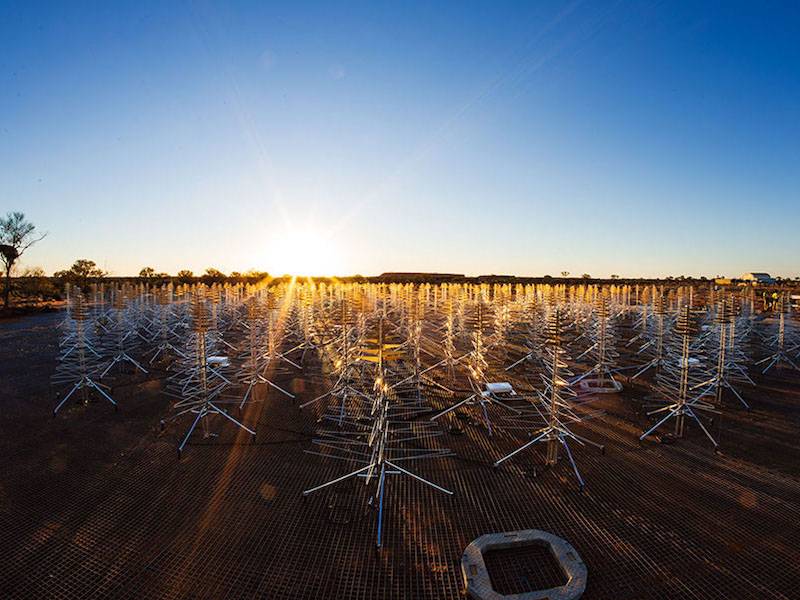Tourism Australia: Written in the Stars

Preparations are underway in Australia to construct a revolutionary radio telescope. When complete, the Square Kilometre Array (SKA) will gaze further into the universe than ever before, answering questions about the origin of the first stars and probing for evidence of life on other planets.
On a red dust plain in outback Western Australia, scientists are building the most powerful radio telescope in the world in a bid to crack the universe’s deepest mysteries.
The Square Kilometre Array (SKA) – one of the biggest scientific projects in history – will allow astronomers to look back to the beginning of the universe, through 10 billion years, to see how galaxies and stars were formed, test if black holes behave as Einstein's theory of relatively and gravity asserts, and even uncover alien life.
“We realised in the mid-1990s that in order to see these very weak signals emanating from the beginning of the universe’s evolution, we needed a big collecting area (a single large telescopic dish or a group of small radio antennas) to collect them all,” says CSIRO's SKA Infrastructure Consortium Director, Antony Schinckel.
“The bigger the collecting area and diameter of a telescope, the smaller the detail you can collect,” he explains. “Big diameter not only gets you larger area and therefore sensitivity to detect the weak signals from the distant cosmos, it gets you resolution, the ability to see very fine detail. Getting that pairing right is key for the SKA.”
The SKA, which is supported by 12 nations, consists of thousands of radio wave detectors sprinkled across Murchison shire in Western Australian and South Africa’s Karoo region; two of the most remote places on Earth with excellent views of the Milky Way.

A sensitive approach
As it’s a low frequency telescope, Australia’s SKA Low is not a traditional dish shape, instead it’s an array of 2m-high antennas spread out over a large distance.
“They look a little bit like a Christmas tree,” says Schinckel, “and there’s going to be about 132,000 of them scattered over an area roughly 65km in diameter. That gives you incredible sensitivity.”
The antennas will collect signals at the lower end of the radio spectrum. Some radio waves derive from just after the the Universe’s beginning and have become weaker and lower in frequency the further they have travelled. By measuring these signals researchers will be able to see deeper into the cosmos than ever before.
Most telescopes don’t have a single scientific purpose. As Schinckel points out “one of the neat things about new telescopes like SKA is that you can do many bits of science at the same time.” Essentially, scientists can take the same data others are looking at and use it to find something very different.
“Certainly, the search for extra-terrestrial intelligence is one goal of the SKA,” he says. “But we still don’t know a lot about some of those early periods and the universe’s birth after the Big Bang.
“One critical period, called the Epoch of Reionization (EOR) – the time when the first stars and galaxies began to give off light – is really interesting. We think the universe went through a transition and was reionized. We’ve seen indicators of it, but we haven’t absolutely proven it to be true. The SKA could tell us.”
The SKA will also allow scientists to search for planetary systems that are just forming, and trace evidence of the molecules that are the building blocks of life.

Generating data and change
Australia has played a key role in the evolution of the SKA, working across the gamut, from design of the infrastructure with industry partner Aurecon, through to intricate digital signal processing.
The SKA will produce an unprecedented sum of big data at an incredible speed, spearheading major global change in technology and software.
“The volumes of data that we have to deal with are so high and so complex so that we still have to design our own custom supercomputer for the initial stages of data processing,” says Schinckel. “That first stage of the processing will sit at the telescope site in the Murchison before the massive volume of data is sent down a fibre optic link to Perth, where a big supercomputer, sitting at the end of the signal chain, will be hosted in Perth’s Pawsey Supercomputing Centre.”
The potential for technology spinoffs from the SKA is enormous.
“One of the reasons the Australian Government – and indeed all governments – is interested, is that it provides good support for local industries, not just in routine industry manufacture but for the development of new techniques and new skills,” says Schinckel.
He cites technology developed specifically for the Australian Square Kilometre Array Pathfinder (ASKAP), the pre-cursor to the SKA.

“We needed some very complex digital computer boards for ASKAP. CSIRO designed them then we found a small company in Newcastle [on Australia’s east coast] called Puzzle Precision who could do this intricate work in high volume and to exacting standards, and worked with them,” he explains. “They have upskilled significantly and are now in a much more elevated technology space than previously.”
CSIRO’s Dr John O’Sullivan – the inventor of WiFi – also contributed, developing special radio receivers that sit on top of the ASKAP and drastically increase its information gathering potential.
Using the ASKAP, an international team including researchers at Curtin University in Western Australia recently may have found all of the missing ‘normal’ matter of the universe hiding in plain sight in the vast space between stars and galaxies, a quest astronomers have been on for almost 30 years.
Key to the breakthrough was ASKAP’s extraordinarily wide field of view and its ability to image in high resolution, enabling researchers to catch fast radio bursts and precisely pinpoint the locations to their galaxies.
The SKA, in turn, will be able to observe larger numbers of fast radio bursts, giving astronomers worldwide greater capacity to dig into our cosmic history.
The SKA is expected to be fully operational by 2027-28, with major construction commencing in 2021.
“One of the most exciting things,” says Schinckel, “is that once the SKA is built and doing the good science we know it will, there’s going to be a whole set of new science opened up that we haven’t even thought of.”
Photo Captions:
-
(Cover Photo) The Aperture Array Verification System for the SKA at CSIRO’s Murchison Radio astronomy Observatory in Western Australia;
-
An aerial view of the low frequency arrays at CSIRO’s Murchison Radio-astronomy Observatory in remote Western Australia;
-
An aerial view of the SKA's Aperture Array Verification System at CSIRO’s Murchison Radio-astronomy Observatory in Western Australia.
-
CSIRO’s Australian Square Kilometre Array Pathfinder (ASKAP) telescope, recently instrumental in finding the Universe's missing baryonic or ‘normal’ matter—a mystery astronomers had been trying to solve for more than twenty years;
Other Articles
About Us
Supported by the Union of International Associations (UIA), the International Association of Professional Congress Organisers (IAPCO) and the Interel Group, the global public affairs and association management consultancy, Headquarters Magazines serve the needs of international associations organising worldwide congresses.















